
Easy and Quick Croissant From Scratch (No Lamination)
Servings: 8 croissants
Calories: 323kcal
I love making this easy and quick croissant because it saves so much time compared to the traditional way of making croissants. This is the easiest and quick croissant recipe I have ever made that yields very good results with lots of layers inside.
Print Recipe
Ingredients
For the dough:
- 300 gr all-purpose flour plus more for dusting
- ½ tsp salt
- 30 gr sugar
- 1 tsp active-dry yeast
- 160 gr milk
- 20 gr unsalted butter (softened)
Filling:
- 150 gr unsalted butter (softened)
Egg wash:
- 1 egg beaten
- 1 tsp milk
Instructions
Prepare the dough:
- I suggest that the room temperature you are at be around 70 F (21 C) or a bit lower, when you make croissants. Turn on the A/C if needed. This is important so the butter doesn't melt. When it melts, you won't get nice flaky layers
- Mix the flour, sugar, salt, and yeast in a mixing bowl of a stand mixer fitted with a dough hook attachment. You can also knead by hand of course. Stir the dry ingredients to combine. Add the milk and the softened butter
- Knead the dough on the lowest speed to combine and then increase the speed to 2 and continue to knead until the dough comes together and smooth. You don't need to reach a windowpane stage here. If you knead by hands, knead for about 5-8 minutes until the dough is smooth
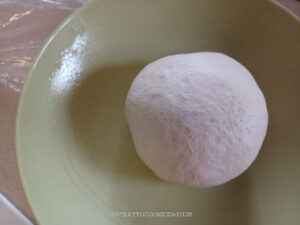
Rest the dough:
- Put the dough in a bowl, lightly sprayed with non-stick spray or brush with some oil to prevent sticking. Rest the dough at room temperature for 30 minutes. It's a short proofing and the dough will not double in size. It's easier to layer the dough with butter when the dough is not full of air

Applying butter:
- After 30 minutes, dust your work surface with some flour, dust off any excess flour. Roll the dough out into about 20 x 60 cm rectangle using a rolling pin and try to deflate any air bubbles at the same time while you are rolling if any. If the dough tears, you can dust with a bit of flour to prevent stickyness
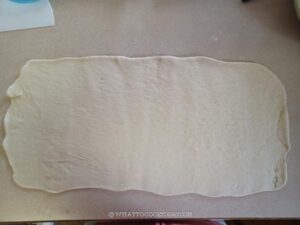
- I suggest wearing a glove so our hand doesn't touch the butter directly. The butter for the filling should be soft but not melting. Use a dough scraper or an offset spatula to help you spread the butter.
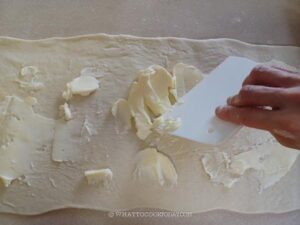
- Make sure it's an even layer all over the surface. You want to apply quickly so butter won't melt
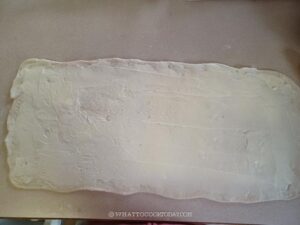
- Roll the dough up tightly from the short side, like a Swiss roll. Wrap with a plastic wrap so the dough doesn't dry out and chill in the fridge for 20 minutes

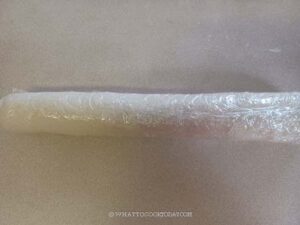
Shaping:
- Line a baking sheet with parchment paper. Dust your work surface with some flour. Take the chilled dough out, the long side near you and use a rolling pin to gently flatten the dough a little bit. You don't want to break the dough and the butter leaks out later.

- Then start rolling out into a rectangle again, about 32 x 23 cm (just roughly), and about 4 mm in thickness. Use a dough scraper to help you make the edge of the dough as neat as possible

- If at any point during this time you notice the butter starts to melt, put the dough back in the fridge for a few minutes to let the butter hardens and then continue rolling it out again
- Make a mark on the edge of the dough near you using a dough scraper or a knife, about 4 cm apart. Then use a dough scraper or pizza cutter to cut the dough into triangles. You can combine the last two half triangles together from the edge of the dough, it won't be a perfect shape, but you can get 8 croissants
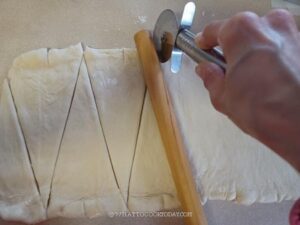
- Work with one triangle at a time, stretch the wide part a bit and then roll it up to form a croissant shape. Make sure the tip of the triangle is facing down on the baking sheet. Gently press on the tip to seal so it won't "uncurl" later. Give them some space so they don't stick together when they double in size. If you use a half sheet pan (18 x 13 inches) , they will all fit in there without being too crowded
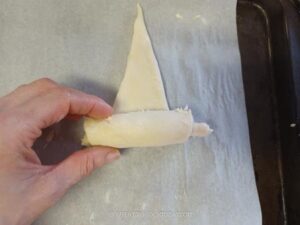
Second proofing:
- Proof the croissant at around 75-77 F (21-25 C). You do not want to proof them at a warm place because we don't want the butter to melt (you will lose the flaky layers inside if it melts!). I just cover them with a clean cloth and put them inside the oven with the light on. This may take 2-3 hours for them to double in size
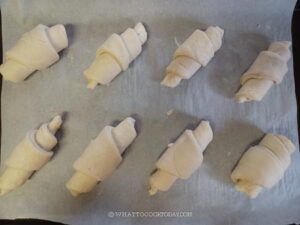
- When you gently press on the dough, it will bounce back very slowly. That's one of the signs that the dough is done proofing. They feel light and puffy too
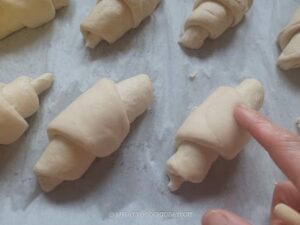
Apply egg wash:
- Once the croissants have doubled in size, very gently apply an egg wash using a pastry brush. I added some sliced almonds. You can skip if you don't want to
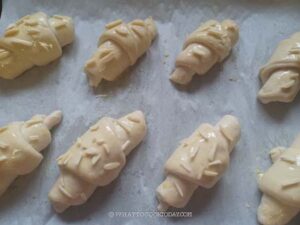
Baking:
- Preheat the oven to 400 F (200 C) for a conventional oven and lower the temperature by 15 F /20 C for convection oven. Position the oven rack in the middle of the oven. While the oven is preheating, put the baking pan with croissants in the fridge to let them chill. I notice the butter doesn't melt as much when the dough is cold.
- Put the baking sheets in the positioned racks. Bake for 20-25 minutes or until deeply golden brown

Cool down:
- Remove from the oven and let them cool down on the tray for 5 minutes and then transfer to a cooling rack. Let them cool down completely before consuming.

Nutrition
Serving: 1croissant | Calories: 323kcal | Carbohydrates: 34g | Protein: 6g | Fat: 19g | Saturated Fat: 11g | Polyunsaturated Fat: 1g | Monounsaturated Fat: 5g | Trans Fat: 1g | Cholesterol: 68mg | Sodium: 303mg | Potassium: 86mg | Fiber: 1g | Sugar: 5g | Vitamin A: 583IU | Vitamin C: 0.04mg | Calcium: 39mg | Iron: 2mg